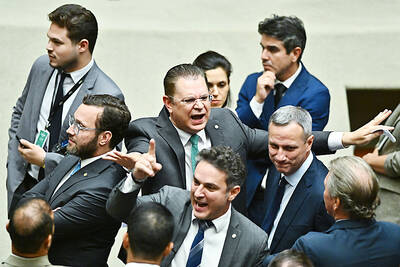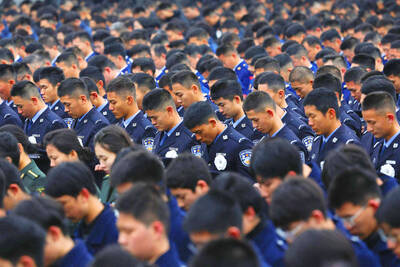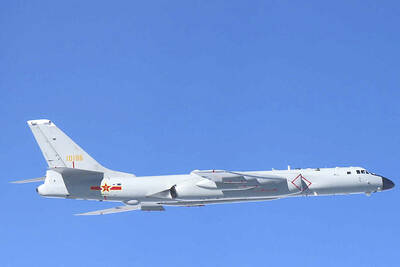Had the terror suspects in London's Tube bombings chosen instead to wreak havoc in the US, it might have been weeks before the world knew what they looked like.
That is because the all-seeing network of 24-hour-a-day security cameras which blankets Britain, and which allowed police to quickly beam pictures of the suspects across the globe, simply doesn't exist in the US.
Though the London attacks have prompted calls for a similar kind of system, any bid to expand the fledgling US network of surveillance cameras could fall afoul of freedom and privacy guarantees in the US Constitution.
"The ethos we have in this country is that government leaves you alone unless it has good reason to suspect you of wrongdoing," said Jay Stanley of the American Civil Liberties Union. "Videotaping everything you do when you leave your apartment or house doesn't really qualify as leaving you alone."
Since the Sept. 11, 2001 attacks, some US jurisdictions have improved their rudimentary closed-circuit TV (CCTV) systems, branded by opponents as "spy" cameras.
"They are pretty scarce, as far as law enforcement CCTV is concerned. There are, of course, a lot of private CCTV networks," said Cedric Laurant, a policy analyst with the Electronic Privacy Information Center (EPIC).
Chicago has around 1,200 cameras, there are more than 200 in Baltimore and there are 20 to 25 police cameras in Washington, as well as a network in Metro subway stations, trains and buses, according to EPIC.

PARLIAMENT CHAOS: Police forcibly removed Brazilian Deputy Glauber Braga after he called the legislation part of a ‘coup offensive’ and occupied the speaker’s chair Brazil’s lower house of Congress early yesterday approved a bill that could slash former Brazilian president Jair Bolsonaro’s prison sentence for plotting a coup, after efforts by a lawmaker to disrupt the proceedings sparked chaos in parliament. Bolsonaro has been serving a 27-year term since last month after his conviction for a scheme to stop Brazilian President Luiz Inacio Lula da Silva from taking office after the 2022 election. Lawmakers had been discussing a bill that would significantly reduce sentences for several crimes, including attempting a coup d’etat — opening up the prospect that Bolsonaro, 70, could have his sentence cut to

China yesterday held a low-key memorial ceremony for the 1937 Nanjing Massacre, with Chinese President Xi Jinping (習近平) not attending, despite a diplomatic crisis between Beijing and Tokyo over Taiwan. Beijing has raged at Tokyo since Japanese Prime Minister Sanae Takaichi last month said that a hypothetical Chinese attack on Taiwan could trigger a military response from Japan. China and Japan have long sparred over their painful history. China consistently reminds its people of the 1937 Nanjing Massacre, in which it says Japanese troops killed 300,000 people in what was then its capital. A post-World War II Allied tribunal put the death toll

‘UNWAVERING ALLIANCE’: The US Department of State said that China’s actions during military drills with Russia were not conducive to regional peace and stability The US on Tuesday criticized China over alleged radar deployments against Japanese military aircraft during a training exercise last week, while Tokyo and Seoul yesterday scrambled jets after Chinese and Russian military aircraft conducted joint patrols near the two countries. The incidents came after Japanese Prime Minister Sanae Takaichi triggered a dispute with Beijing last month with her remarks on how Tokyo might react to a hypothetical Chinese attack on Taiwan. “China’s actions are not conducive to regional peace and stability,” a US Department of State spokesperson said late on Tuesday, referring to the radar incident. “The US-Japan alliance is stronger and more

FALLEN: The nine soldiers who were killed while carrying out combat and engineering tasks in Russia were given the title of Hero of the Democratic People’s Republic of Korea North Korean leader Kim Jong-un attended a welcoming ceremony for an army engineering unit that had returned home after carrying out duties in Russia, North Korean state media KCNA reported on Saturday. In a speech carried by KCNA, Kim praised officers and soldiers of the 528th Regiment of Engineers of the Korean People’s Army (KPA) for “heroic” conduct and “mass heroism” in fulfilling orders issued by the ruling Workers’ Party of Korea during a 120-day overseas deployment. Video footage released by North Korea showed uniformed soldiers disembarking from an aircraft, Kim hugging a soldier seated in a wheelchair, and soldiers and officials